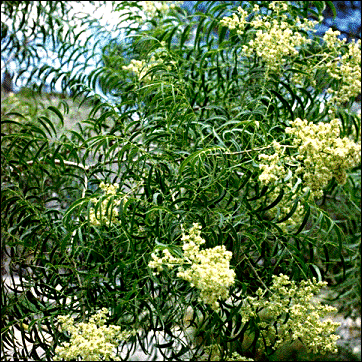
Long before modern manufacturers hawked their wares, Chihuahuan Desert inhabitants made do with local natural resources—resources not necessarily inferior to some later, much ballyhooed products. Many people are aware that yucca root has been used as a shampoo, but fewer know of another modest contributor to cleanliness—the plant currently known in Mexico as jaboncillo and to Southwestern plant lovers as Western Soapberry. The fruits contain saponin, which produces lather that has been used, even in historic time, as a soap for the washing of clothes. Saponin is poisonous, but has been used cautiously in folk medicine to treat fevers, rheumatism, and kidney problems.
This small tree grows, usually in groups, along streams and arroyos in
the northern part of the desert. The lather-producing fruit consists of attractive,
translucent, amber-colored spheres, the ultimate result of large white clusters of
flowers that may bloom from April to August--particularly in early June in the
Trans-Pecos. A fast grower, the plant has been used as a windbreak. As an attractive
native, greater use as an ornamental is overdue.
![]()
Contributor: Arthur H. Harris, Laboratory for Environmental Biology, Centennial Museum, University of Texas at El Paso.
Desert Diary is a joint production of the Centennial Museum and KTEP National Public Radio at the University of Texas at El Paso.

Western Soapberry in bloom. Photograph by Wynn Anderson.